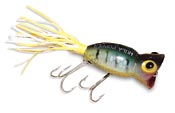August Walleye Lure of the Month: Rapala 07 Floating Silver Lure
In the 1930's, Lauri Rapala had a very simple revelation: wounded fish get eaten by big fish, so all he needed to do was to create a lure that resembled a wounded minnow. Such a simple thought process, but it is one that has transcended generations and helped to catch millions of fish. The Rapala Original Floater was originally made of timber, and has since been updated to what is included in this month's selection. It's easy to use, durable, and most importantly - it catches fish!
Used as a trolling lure, it is easy to maintain a consistent speed. Also because of the balsa wood construction, you will find that it has a nice, rolling action through the water, further enticing the fish. If you are lure casting, simply cast it out and pull it back in.
As a variation, if you see fish flashing at the lure but not striking, try this: cast it out, increase the tempo of the retrieve, and add in short, sharp stops that get the Rapala minnow darting and weaving, darting and weaving. This may "wake up" the fish that were previously not interested, and get them to chase and try to catch the lure with a new life to it.
For more info, check out FishingEnthusiast.BlogSpot.com to watch a video put together by Patrick Brennan on best practices of fishing this beautiful lure!
Features:
*Swimming Depth: 0.6-1.8 m
*Available in classic and bleeding patterns
*Can be fished top to bottom
*Balsa Wood Construction
*Natural Minnow Profile
*Run Fast or Slow
*VMC Hooks
www.FishingEnthusiast.com



